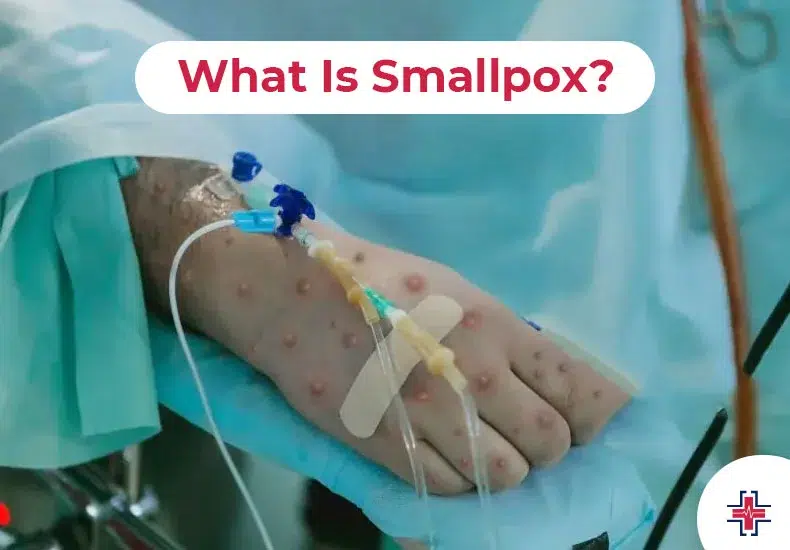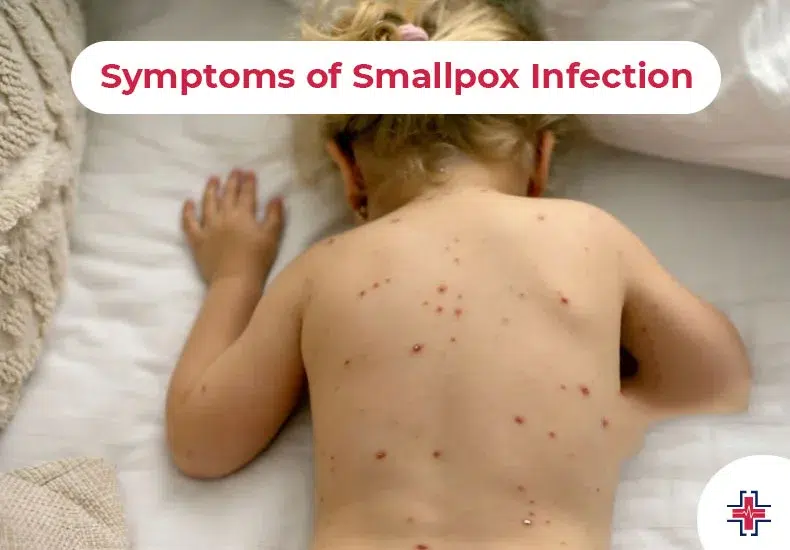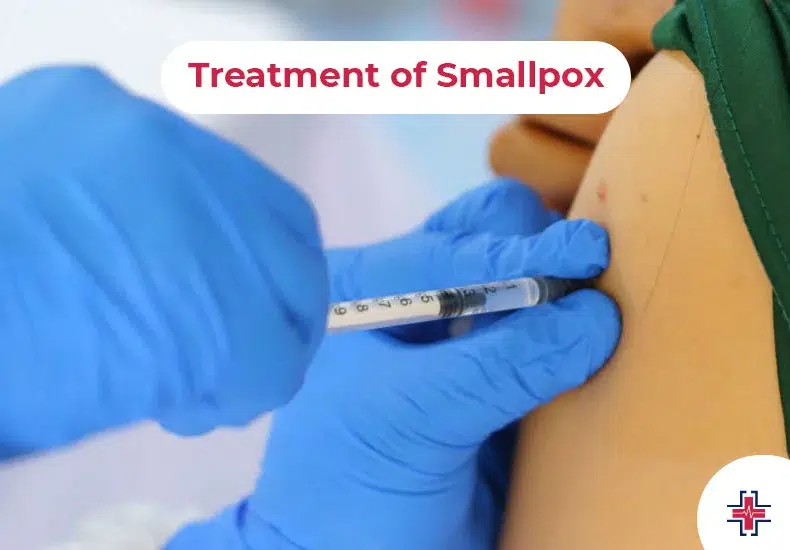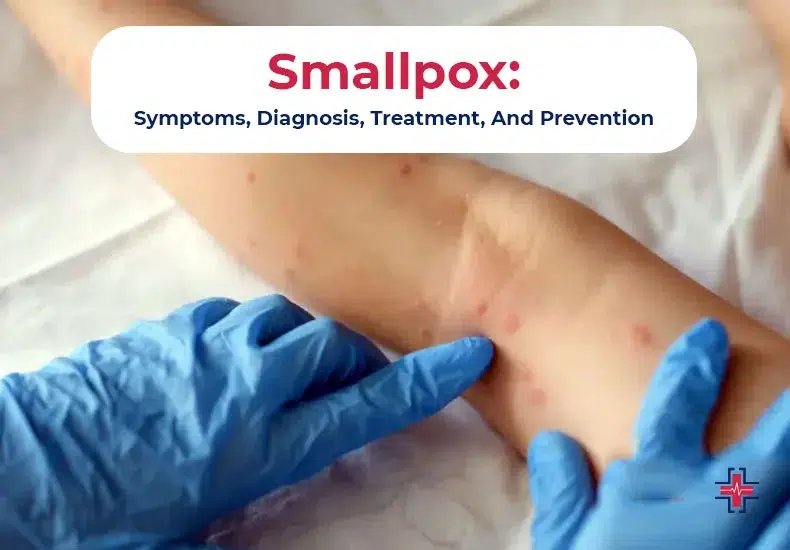There was a high survival rate from smallpox, but there were also significant death rates. The smallpox mortality rate was approximately 30%. In addition, many illness survivors experienced severe scarring or sometimes lost their vision. The smallpox virus has been eradicated since a vaccine was developed. The successful invention of the smallpox vaccine was a significant milestone in the advancement of modern medicine, as it was the first of its kind.
The definition of smallpox and the individuals it affects are examined in this article. We also discuss smallpox symptoms, treatment, and if it could return.
What Is Smallpox?
Until the late 20th century, it was a highly contagious disease that caused harm to people. Although its exact origins are unknown, doctors assume that it has been around for approximately 3,000 years because of rashes resembling smallpox that were discovered on some mummies from ancient Egypt.
The smallpox virus caused it. This virus is a member of the orthopoxvirus family, including cowpox and monkeypox. According to historians, writing about smallpox dates back to the fourth century in China.

Over the ages, the variola virus spread to other countries and regions due to human activity. By the sixth century, trade had allowed it to reach Korea and Japan, and as empires grew, it also made its way across North Africa, Spain, Portugal, the Middle East, and North Africa.
In the eleventh century, smallpox was introduced to northern Europe by the Crusades. Smallpox was then brought from Portugal to western Africa by colonialism and the slave trade, and it was subsequently carried over the Atlantic to the Caribbean, North America, and South America. Here, it wiped out Indigenous peoples’ populations.
The smallpox outbreak was a disease that rapidly dispersed over a broad geographic region. It was among the deadliest illnesses that people have ever encountered.
How Did Smallpox Spread?
The smallpox virus can spread from symptoms until the scabs come entirely off.
It may increase even through:
- Contact with a smallpox patient’s bodily fluids
- Airborne transmission by saliva droplets released when a smallpox patient coughs or sneezes
- Sharing clothes or bedding with a smallpox patient
Types of Smallpox
Four varieties of smallpox exist. Among them were:
- Variola minor: A frequent smallpox subtype that is less deadly. Less than 5% of people sick died, according to an analysis of studies conducted in 2021.
- Malignant smallpox: An extremely uncommon and fatal form of smallpox in which the lesions do not turn into pustules or skin lumps filled with pus. Instead, they stayed plump and pliable for the duration of the sickness.
- Variola major: A more prevalent and fatal virus strain. According to the same analysis, 30% of cases resulted in death.
- Hemorrhagic smallpox: An uncommon and fatal form of smallpox in which blood seeps from organs into the skin and mucous membranes.

What Steps Did We Take To Eradicate Smallpox?
The following are a few things that might have helped eradicate smallpox:
- People only contract smallpox. Neither insects nor animals can spread it. Fewer avenues for infection result from this.
- It dispersed somewhat slowly. Until an infected individual became too ill to be around many other people, smallpox was usually not contagious. It is usually disseminated among household members.
- Outbreaks were contained by ring vaccination. Health officials might use “ring vaccinations” to contain smallpox epidemics because the disease only spreads among intimate contacts. This entailed immunizing just individuals who had recently come into touch with an infected person.
- It was simple to recognize. Every smallpox victim experienced symptoms, such as a recognizable rash. There were no carriers of smallpox who were asymptomatic.
Are There Still Cases of Smallpox?
The only contagious disease that people have successfully eradicated is smallpox. There are still some variola virus samples in a few secure laboratories, but these are the only ones known to survive. There isn’t a variola virus that affects people.
Smallpox was finally eradicated thanks to the development of the first effective vaccine in history. A British physician named Edward Jenner noticed near the end of the eighteenth century that milkmaids who had previously experienced cowpox did not contract smallpox. This led him to conclude that cowpox, caused by a less severe orthopox virus, might shield a person from the more serious illness.
Although he developed the first vaccination in 1796, it took a while for people to start using it. Many people did not trust that the vaccine was safe and were terrified. However, as time passed, researchers improved the vaccine, and public awareness of this preventative measure increased. The WHO proclaimed smallpox eliminated in 1980, with the last naturally occurring case in 1977.
Symptoms of Smallpox Infection
Smallpox symptoms progress over time and include
- Elevated temperature.
- Sores, followed by rash-related hard pustules.
- Severe headache.
- Back pain.
- Rash that originates in your mouth moves to your face and eventually spreads throughout your body.
- Stomach ache.
- Extreme weakness and exhaustion.

The first symptoms to manifest are fever, headache, and exhaustion. They last for two to four days, although when the rash appears, the fever may stay the same or return. After that, the rash develops in phases that last a few days each.
Smallpox Rash: What Does It Look Like?
The smallpox rash first appears in your mouth and face and soon spreads over most of your body. It begins as a rash and progresses to hard lumps that eventually develop scabs. When someone has ordinary smallpox, the most frequent kind, the rash goes through multiple stages:
- First rash. A rash appears on your tongue and the interiors of your mouth and throat following the onset of symptoms. Your mouth’s red spots turn into sores that eventually burst.
- Rash spreading. The rash affects your face, arms, legs, back, and chest. It covers your entire body, including the palms of your hands and the soles of your feet, in about a day.
- Pus (thick fluid) collects in skin bumps. Every bump might have a dent in the center of it. The bumps fill with fluid for approximately two days.
- Scratches and pustule rash. Pustules—firm, spherical lumps—develop from bumps. The bumps develop crusty scabs during the following ten days.
- Scabs decide. The scabs peel off over a week or so, leaving scars behind.
How Is Smallpox Diagnosed?
Rashes can be a symptom of several disorders. However, it is highly improbable that a rash is caused by smallpox.
The following are the main smallpox diagnostic criteria:
- A fever with a minimum temperature of 101 degrees Fahrenheit (38.3 degrees Celsius), occurring one to four days before the appearance of a rash, and at least one additional symptom such as excessive weakness, headache, backache, chills, vomiting, or intense abdominal pain
- Traditional smallpox lesions as previously mentioned
- Lesions on a single body part that are at the same stage of development (for example, having only bumps on the arms as opposed to blisters and pustules mixed)
someone likely has smallpox if they fit the description as mentioned above. The following are minor diagnostic criteria (lower likelihood):
- A rash where the face and extremities have the highest concentration of lesions
- Lesions that start as mouth, facial, or forearm lesions
- Severe sickness
- Rash that gradually transforms into many forms
- Ailments on the hands’ palms or the feet’s soles
- Laboratory testing can confirm a smallpox diagnosis and rule out other possible diseases, like chicken pox.
Treatment of Smallpox
Treatment for smallpox in the past involved isolating the patient until all the scabs fell off to relieve symptoms and stop the illness from spreading. However, researchers have created antiviral drugs to treat smallpox in recent years.
The medication tecovirimat (TPOXX) was licensed by the U.S. Food and Drug Administration (FDA) in 2018 to treat smallpox. The medication prevents the action of a protein known as p37, which stops virus particles from escaping an infected cell and infecting other cells.

According to research, tecovirimat can treat illnesses akin to smallpox in animals and is effective against the variola virus in lab conditions (in cell cultures). Additionally, studies demonstrate the safety of tecovirimat, with headache, nausea, and abdominal pain being the most common side effects.
However, because the medication was created after smallpox was eradicated, human testing has not been conducted on it, raising questions about how well it would function in the extremely improbable case of an outbreak.
Further research has demonstrated that the antiviral medications brincidofovir, an experimental medication also used to treat adenovirus and cytomegalovirus retinitis in patients with AIDS, and cidofovir (Vistide), which is occasionally used to treat cytomegalovirus retinitis in eye infections in AIDS patients, are both effective against smallpox in laboratory settings and can treat diseases related to smallpox in animals.
Patients who have smallpox have not been tested for cidofovir or brincidofovir. Researchers are still looking at the toxicity and efficacy of the medications.
Prevention for Smallpox
- People with smallpox should not go to daycare, preschool, school, or work until all scabs have fallen off and they have received clearance from the Chief Quarantine Officer of the ER of Dallas to return.
- There is a vaccine on the market. In Australia, the National Immunization Program does not cover smallpox vaccination and is not generally advised. Unless it is contraindicated, vaccination is advised for laboratory personnel who regularly handle vaccinia poxviruses.
- South Australia’s health department, along with health departments around the world, is preparing for the potential that smallpox could be purposefully deployed as a bioweapon.
- Smallpox cases should be promptly isolated until they are no longer contagious.
Do We Still Vaccinate For Smallpox?
Doctors no longer administer smallpox vaccinations regularly. specific demographics, such as military personnel and researchers, continue receiving smallpox vaccinations. Vaccines against smallpox are kept in reserve by the US government in case of another outbreak.
Why Is There a Scar From The Smallpox Vaccine?
The smallpox vaccine employs vaccinia, a live, unaltered smallpox virus, in contrast to most modern immunizations. Instead of injecting you, a doctor punctures your shoulder and inserts a double-ended needle into the virus. You get vaccinia at the vaccine site. An infection-related blister eventually leaves a scar.
Those who receive this kind of smallpox vaccination need to pay special attention to the directions for caring for the injection site. Should they fail to do so, they may infect someone else with the vaccinia virus. There are two types of this vaccination: ACAM2000 and APSV.
Side Effects of the Smallpox Vaccine
The smallpox vaccination does not require an injection or “shot,” unlike most other immunizations.
Instead, a bifurcated (two-pronged) needle dipped in the vaccination solution is used to inject it. A physician punctures the skin (typically the upper arm) several times in a matter of seconds with a needle.

A red, itchy lesion forms at the injection site within three to four days after a successful vaccination. In the first week, this lesion becomes a big blister that fills with pus and starts to drain. In the second week, it starts to dry and scab over; in the third week, it falls off, leaving a little scar.
The vaccinia virus can quickly spread throughout this process to other parts of the body or people by touch. A dangerous infection that could endanger vision can result from touching the vaccine sore and the eye. It’s also possible for the vaccine sore to turn into a dangerous allergic or toxic rash.
Rarely, recipients of the vaccination experience additional severe or potentially fatal side effects, such as
- Heart pain and heart attack, Heart lining inflammation, or both
- Eczema vaccinatum is a severe rash that develops in individuals who already have skin disorders, such as eczema or atopic dermatitis, and who contract the vaccinia virus via another immunization.
- In patients with compromised immune systems, progressive vaccinia, or an accumulation of inflammatory tissue at the vaccination site, can occur.
- Inflammation of the brain
FAQs
At What Age Was The Smallpox Vaccine Given?
At one point, all children in the United States received a different smallpox vaccine at the age of one year. Smallpox risk had significantly decreased in the United States by the 1960s.
How Long Does The Smallpox Vaccine Last?
According to specific research, the smallpox vaccination can offer protection for several years. Every three years, the Centers for Disease Control and Prevention (CDC) advises obtaining a booster shot for people who require smallpox immunization for their line of work.
Smallpox Vaccine: When Did It Stop?
The public can no longer get the smallpox vaccination. The United States discontinued its routine smallpox immunization program in 1972. The World Health Organization (WHO) declared the eradication of smallpox in 1980. As a result, there is no need to safeguard the general people from the illness.
How Long Has The Smallpox Vaccine Been Around?
Two months later, in July 1796, Jenner utilized human smallpox sore material to inoculate Phipps to determine the degree of resistance. Phipps, the first person to be vaccinated against smallpox, remained in perfect health. Vaccination of smallpox victims with Edward Jenner; colored etching after J.
Summary
Smallpox was a dangerous viral illness brought on by the variola virus. Historians estimate its age to be around 3,000 years. Three victims out of ten died from it, demonstrating how deadly it was. Fever, vomiting, headaches, bodily aches, and a rash that turned into pimples and scabs were among the symptoms of smallpox. The development of the first immunization allowed individuals to prevent illness even though there was no cure.
The last recorded case of smallpox that developed on its own happened in 1977 in Somalia. After years of widespread immunization campaigns, the World Health Organization eradicated the disease in 1980. Scientists are still working on creating a variola virus-targeting drug in case people ever need one.
